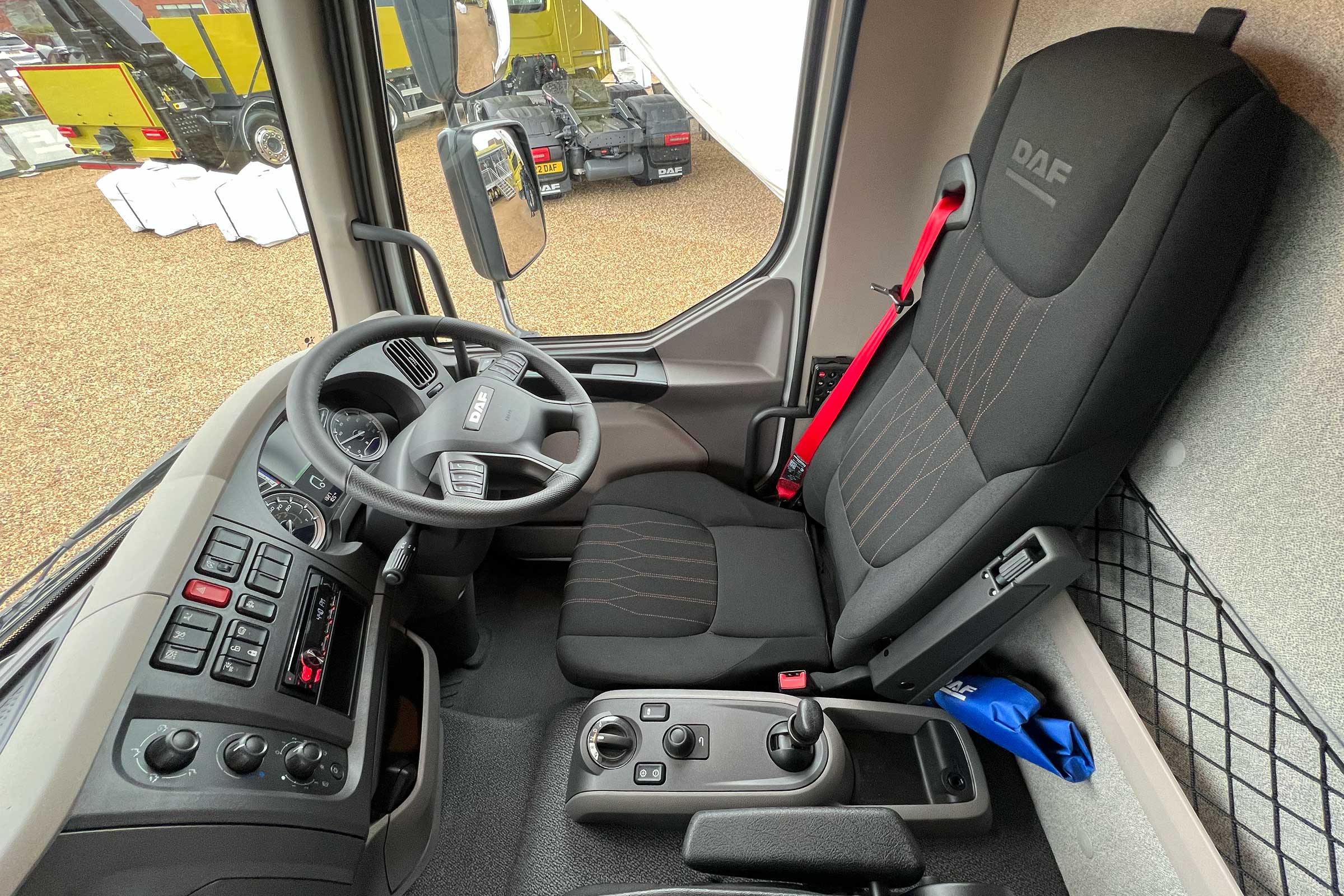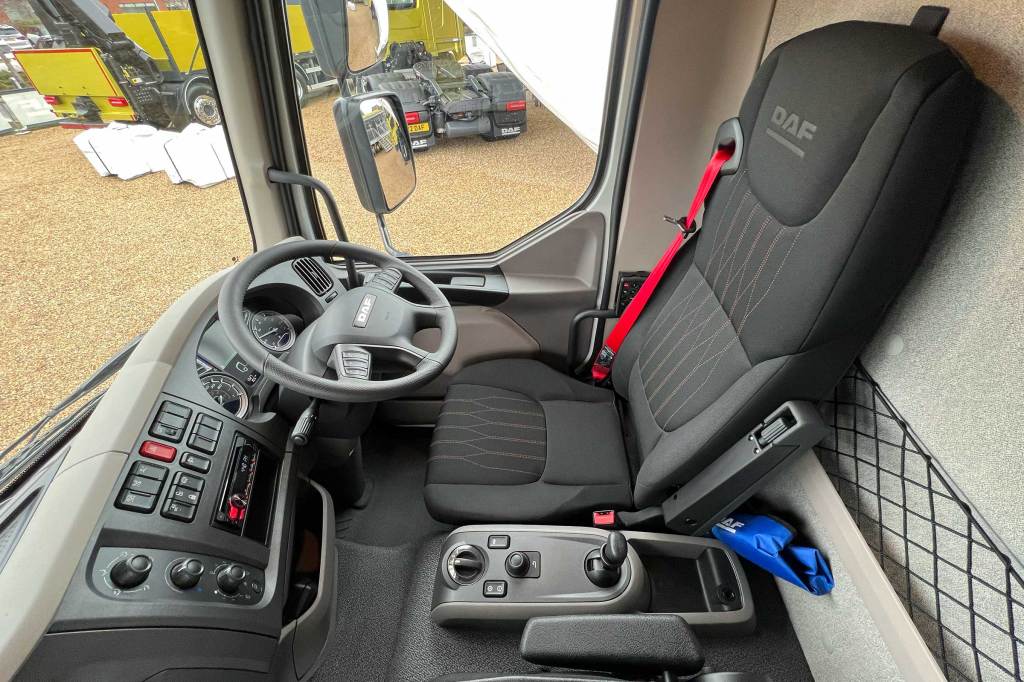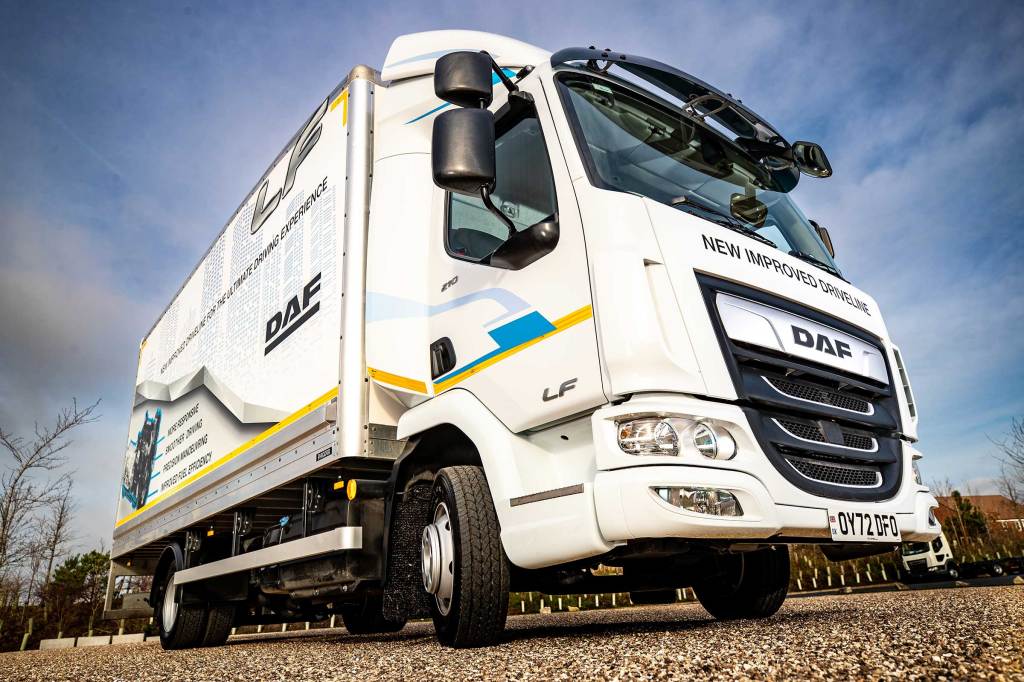Driven: DAF LF210 4×2 7½-tonner

DAF has just announced its 'new' XB model, which is an LF with a new grille. We took one of the last for the 'old' LFs out for a spin. Since it got into bed with Leyland in the mid-1980s and eventually took the company over, DAF has been top of many a list for those hauliers wanting a decent 7 1/2 -tonner.
They have always been popular for parcel delivery companies, utilities, county councils and what are effectively 'support vehicles' for last-minute panic deliveries for operators who typically have an all-artic fleet. The market for trucks with this weight has declined since the late 1990s when the law was changed on January 1 1997. Before then, you could drive a 7 1/2 -tonner on a car licence.
Thereafter, you needed a Class C rigid truck licence, although grandfather rights were retained for those who had passed the car test before that date. So ever so slowly, the number of people who can legally drive a 7 1/2 tonner has steadily declined. The need to have an HGV licence meant 10- and, especially, 12-tonners became more popular as they were - pretty much - the same size as a 7 1/2 -tonner but obviously more productive.
However, one area where the 7 1/2 -tonner still has its own USP is access to the number of roads - especially in residential and urban areas - where there are weight restrictions which exclude anything heavier than a 7 1/2 -tonner. So the weight class, while declining, as mentioned, still has a lot of fans and is far from dead. The 7 1/2 market also has two distinctive types of trucks.
Those which use cabs shared with bigger rigids - such as the subject for his Driven piece - the DAF LF, as well as the MAN TGL, Mercedes Atego and Iveco Eurocargo, and those which have cabs shared with, or similar to, those used on smaller vans, such as the Iveco Daily (which, technically is a 7.2-tonne GVW rigid), the Fuso Canter and Isuzu N75. The latter offer more payload but less driver comfort. The current market leader in the sector is the DAF LF, and has been for many years.
In between my road test of this LF210 and publication, DAF has relaunched its lightweight range as the XB to keep it in line with the looks of the XD, XF and XG models, although the 'new' truck used the same LF cab and the new grille and facelift does little to hide that fact. More on that later. Not long before that relaunch, I took an LF210 7 1/2 -tonner out for a trip around the towns, villages and cities close to the DAF's UK base at Haddenham.

Technical overview
The badge gives away that this has the 213hp output of the PX5 4.5-litre Euro 6e four-cylinder engine with a very usable 850Nm of torque.
That is the highest rating from the smallest engine now offered - you can have it as the LF170 (172hp) or LF190 (184hp) and, at this weight, also as the LF230 (at 234hp). That latter truck moves you up to the bigger six-cylinder 6.7-litre PX7 engine and so adds a fair few kilos of extra weight on what is already a heavy chassis for the payload that can be carried, and you don't need 234hp for a 7 1/2 -tonner. You don't realistically need 213hp, but more operators are specifying higher-power engines even for lighter trucks.
The gearbox is the standard fit eight-speed automated manual, but as options, there are both six- and nine-speed manuals and the Allison fully-automatic six-speed gearboxes. Some operators still prefer a manual at this end of the weight spectrum. The front axle is rated at 3,200kg and the rear at 5,000kg, and the truck was fitted with 215/75R17.5 tyres throughout.
The rear axle ratio was 1:3.73. The wheelbase was 4,300mm.
In the cab
Being such a little truck, it only needs a single-step entry, and two grab handles and a wide opening door make entry into the cab exceptionally easy. As to be expected, the truck had a day cab, although it can be ordered with an extended day cab and a sleeper cab, both more popular at this weight than they were many years ago.
The extended cab option gives the driver much more room, of course, and it does not need to have a bunk fitted. Instead, that space can be specified with three additional lockable storage boxes behind the seats. The sleeper cab has a small bunk, you wouldn't really want to tramp in it - though I bet someone does - but good and cosy enough for the occasional night bedding down while out on the road.
The cab is very compact, has three seats, and is very comfortable. The centre seat has a useful flip-down feature, and three cup holders are in its back. This is great if you are on your own or in a two-man crew, but it obviously can't be used if it's a three-man crew.
Behind it is a small net for magazines, paperwork or other nickknacks. If you don't opt for the third seat, you can use its space for a document tray with two cup holders, and this is probably the optimal set-up for this truck unless you are a scaffolding company or other workmen-type truck where getting bodies to site is important. For parcel delivery companies and the like, the two-seat set up is better.
Back to the layout of my test truck, in between the seats, to the driver's left is the gear selector and handbrake, which are very well placed. Given the work this kind of trucks do, many drivers will like having the handbrake in this position. The passenger door has a lower window, only useful if you are driving on your own.
To accommodate this, the main window would not be able to lower, so to open it, it's a two-piece split sliding window, which few people like but is a necessary evil given the growing demand for these lower windows. However, the cab is quite cramped, so don't be surprised if that footwell is used for dumping the driver's stuff! There are a couple of small pockets above the windscreen for storage, but given this is a flat roof cab, they are only useful for little bits and pieces.
The dash is similar to other DAFs but much simpler. It's fairly basic - speedometer to the left, rev counter to the right with fuel and AdBlue gauges and other necessary information. It does look a bit dated.
Maybe that's because bigger trucks are all moving to digital dashes, and the little 'uns are seemingly being left behind. A few controls on the steering wheel, such as volume and the most basic cruise control facilities. To the left of the main fascia are the temperature control and other buttons.
The layout is simple but effective and not overly confusing for drivers. There are two stalks, one for the wipers and the other for the indicators. The wing mirrors are the conventional six mirror set up.
Despite DAF having its new Digital Vision System cameras, this has not been included on the new XB models, so the little trucks stay 'old school'. That is the case with Mercedes, and so far, only MAN has decided to offer digital mirrors for its entire range. I'm unsure why, as surely the XB would benefit from them.
The LF cab was launched in 2001 to replace the old 45 Series cab was the Leyland-designed Roadrunner cab unveiled in 1984. The new cab was shared with Renault for the Midlum and is still used by the company for its Range D Distribution models, and is also by Volvo for some of its 12-26 tonne models in the FL and FE ranges.
So you cannot deny it is dated - more so when you consider there is a lot of Roadrunner about it. BUT... there is only so much that can be done on a small cab, and also the sales do not justify masses of R&D costs to devise a wholly new cab.
But that does not mean they should be overly basic, they need to be comfortable for when they are being driven. That said, with three burly men in the cab, there is not enough room for them to be comfortable for long periods, especially if they all have a bag and want to bring their coffee. But in such cases, the demands of drivers of these trucks are likely to be far less.
Most are used for day work only, usually by any driver rather than one truck and one driver. They cover shorter distances and are often used in roles where they are merely a loaded taxi, and the driver spends much of their working day out of the cab working on the job in hand! But there is no escaping the fact that the cab is now, by today's standards, probably deemed just that bot too old, cramped and basic.
The LF cab is used up to 18 tonnes and for that heavier role, I would, personally, opt for the XD, unless squeezing out every kilo of payload is your priority. The XD cab is - presumably - too big to scale down for this weight, and even if it were, it would probably make the trucks overly heavy and so uncompetitive on the payload, as MAN's TGL proves. At 12 tonnes, however, a scaled-down XD cab might be plausible, but again, I doubt the take-up would be enough to warrant its development.
However, it is worth mentioning that the XD (and indeed CF) cab is available at 18 tonnes - and now with the PX7 engine.

On the road
The all-round vision of the truck is pretty good, and being sat so low down gives you a good view of the road and - more importantly - vulnerable road users. These trucks will spend a lot of their time in urban areas so that is good. Having so much power on board meant the truck was understandably very nippy indeed.
As I say, the LF170 and LF190 would be ideal at this weight, and you don't need such grunt, but it does help you pull away from traffic lights and roundabouts that much easier, which is a useful plus point. Indeed, that could save you a lot of time throughout the working day if you have to negotiate many junctions in busy and congested areas. If nothing else, it will give you greater comfort when pulling out.
Of course, the 7 1/2 -tonner still is also a common sight on ring roads, dual carriageways and motorways, and here the extra power is, again, also helpful for quickening journey times. The engine brake button was on the steering wheel, and if I am honest, I didn't find either especially useful or user-friendly, and I spent most of the drive using the footbrake. Again, given its use's stop/start nature, I would imagine that would be the preferable option for many drivers.
The brakes themselves were fine and the steering was also very good, not heavy at all, or, indeed, overly light.
The ride quality was a little noisy and bumpy as well. However, the latter can probably be put down to the road quality, which seems to deteriorate wherever you drive within the UK. In fact the state of the country's roads is now getting beyond a joke both for quality of the surface and the ability to read the painted road markings on them which seem to be fading to the point that they are becoming utterly useless, and indeed borderline dangerous.
But handling the LF210 around the town and city roads around Oxford was enjoyable enough.
A useful feature for town driving is the auto engine switch off, which clocks in after five minutes of idling - for a truck like this, a three minute cut out might be better. Still, if you are in London, Birmingham or Manchester and it's nose to tail peak hour traffic, it's handy. The truck, with its body and tail lift weighed in at 5,220kg, so that's only just a shade over two tonne payload, but for a lot of jobs payload is not always the biggest concern.
If you need more then you need to look away from DAF or look at the 10- or 12-tonners which will only weigh a fraction more - a six tonne payload on an LF210, or even an LF230, 12-tonner should be possible.
Verdict
The 7 1/2 -tonner is not the truck it once was because of the aforementioned legislation changes that happened, er, 26 years ago, In other words no one below the age of 43 will have the car driving entitlement to drive one, and so the 12-tonner becomes a much better bet if you have to have an HGV licence. But for town deliveries, and for those areas where the dreaded 7.5 ton signs can be seen, then they still have a very important role especially where payload is not the biggest concern. They have never had a great payload capability, especially after bodies are fitted (and often they includes a heavy tail lift!), and so getting 3 1/2 tonnes on the back is seen as a great result for this type of truck.
The 7 1/2 -tonner can also be very versatile, even for specialist roles such as a skip lorry or fuel tanker, and they can allow a truck to get into places were bigger vehicles simply cannot fit - such as the tight narrow lanes of Cornwall or congested city centres. Is the LF a good fit? Yes, of course it is, and its sales figures back that up.
It's a competent machine that has a wide range of options for operators especially in drivelines. I would argue the Mercedes Atego has a slightly better cab, and that MAN TGL is on a par with it as well - but DAF's superior back up, its excellent build quality and the aforementioned variety of options means it will always be at the top of the tree. The XB will move it forwards slightly, not as much as, perhaps, many might have expected or have liked, but it will still please operators, and so it should because at 7 1/2 -tonnes, the little DAF is a very decent bit of kit indeed.
The LF will remain in production for a little while before it morphs into the XB, but the fact remains the little DAF is a winner and has a lot going for it.
We like
- Lots of options
- Lively performance
- Great handling
- Great back up
- 'Big truck' feel
We don't like
- Cab is dated
- A bit noisy inside
DAF LF210 FA
- Design GCW: 7,500kg
- Chassis: 5,500mm wheelbase
- Front axle: 3,200kg capacity.
- Rear axle: 5,000kg (drive), 3.73:1 ratio.
215/75R 17.5 tyres
- Gearbox: automated 8-speed
- Engine: PX5 4.58-litre straight six
- Max power: 213hp @ 2,300rpm
- Max torque: 850Nm @ 1,200-1,500rpm
- Cab: Day, three seats
This first appeared in the NOVEMBER 2023 issue of Trucking Mag.
You can order single copies or a digital or print subscription online